Native religion in Roman Britain: the evidence
What was the ‘native’ religion?
Aldhouse-Green provides us with perhaps the best definition of ‘native’
cults, deities and sanctuaries, as being those ‘that apparently had their genesis
in the cosmological systems and paradigms of western Europe outside the Mediterranean
littoral’ (2004, 193). An examination of the evidence shows that the nature
of the Celtic/native religious beliefs in Britain during the time of the Romans
can be broken down further into one of three types:
- truly ‘native’, i.e. originating in the British pre-Roman Iron Age,
and continuing to be worshipped by the Romano-British populace
- ‘native’ but originating during the Roman occupation of Britain
and worshiped by the populace
- brought into the province by non-British Celts, who could be either
civilians, i.e. traders/merchants, or the military.
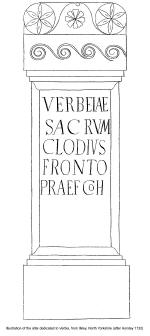 Celtic religion was expressed as a belief in ‘the spirits of nature. Sea
and sky, mountains, rivers and trees…the sun, the source of heat and light,
and the moon, the measure of time…’ (Birley 1964, 136). All were thought to
be endowed with powerful spirits, as were certain animals and birds, seen as
having impressive attributes, and all deserving of worship by prayer and sacrifice.
Henig (1984) further emphasises this connection between natural features and
the divine world and claims that place-name evidence suggests that rivers in
particular received names long before the Celtic language was spoken, i.e.
the Thames may have been so named in the Bronze Age or earlier (ibid. 17). Further examples of the worship of these personified natural features include
Verbia, meaning ‘winding river’, attested on an altar at Ilkley, North Yorkshire
(RIB 635). This connection with water - the veneration of rivers and watery places,
especially bogs - is also attested in the numerous offerings of precious objects.
The
earth itself was also thought to be sacred. Shafts were sunk into the ground
in the Bronze Age and became more frequent in the Iron Age and Roman periods.
Evidence of sacrifices in these pits, along with the presence of great timbers,
suggests a symbolic sexual penetration of the earth thus constituting fertility
magic.
Celtic religion was expressed as a belief in ‘the spirits of nature. Sea
and sky, mountains, rivers and trees…the sun, the source of heat and light,
and the moon, the measure of time…’ (Birley 1964, 136). All were thought to
be endowed with powerful spirits, as were certain animals and birds, seen as
having impressive attributes, and all deserving of worship by prayer and sacrifice.
Henig (1984) further emphasises this connection between natural features and
the divine world and claims that place-name evidence suggests that rivers in
particular received names long before the Celtic language was spoken, i.e.
the Thames may have been so named in the Bronze Age or earlier (ibid. 17). Further examples of the worship of these personified natural features include
Verbia, meaning ‘winding river’, attested on an altar at Ilkley, North Yorkshire
(RIB 635). This connection with water - the veneration of rivers and watery places,
especially bogs - is also attested in the numerous offerings of precious objects.
The
earth itself was also thought to be sacred. Shafts were sunk into the ground
in the Bronze Age and became more frequent in the Iron Age and Roman periods.
Evidence of sacrifices in these pits, along with the presence of great timbers,
suggests a symbolic sexual penetration of the earth thus constituting fertility
magic.
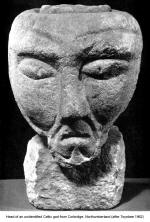
 The cult of the head also formed part of the Celtic belief system. Human
heads were seen as totems of power. A head could be severed from an enemy in
battle and yet retain life independent of the body. The head in Celtic imagery is often shown stylised, with almond shaped eyes, long nose, and a slit mouth:
whilst the head on divine images is often shown with horns or antlers, reflecting
another belief – that of the Img38.htm.
The cult of the head also formed part of the Celtic belief system. Human
heads were seen as totems of power. A head could be severed from an enemy in
battle and yet retain life independent of the body. The head in Celtic imagery is often shown stylised, with almond shaped eyes, long nose, and a slit mouth:
whilst the head on divine images is often shown with horns or antlers, reflecting
another belief – that of the Img38.htm.
Specific sites of native worship would have had their own individual rites
and ceremonies, for the power of Celtic deities appears to have been very much
tied to specific locations.
Interpretatio Romana
‘The practice of conflating Roman with indigenous god-names was endemic
within the Roman Empire, and should, perhaps, be read as a mechanism for the
negotiation of socio-economic identities which may have been presented in terms
of equal (or near equal) partnership between romanitas and local tradition’ (Aldhouse-Green 2004, 201).Aldhouse-Green points out that
it is often difficult to distinguish between the ‘native’ British deities who
have undergone hybridisation (and are hence
termed Romano-Celtic) and those which have remained ‘native’, being entirely
Celtic in concept (1983, 51). Two examples of this are Sulis Minerva and Coventina.
At Bath (Aquae Sulis) in Western England
Roman engineers transformed a spring, possibly a focus of worship in the Iron
Age, into a great ornamental pool, probably embellished with statues and enclosed
in a grand building. Beside it they built a temple of Mediterranean type and
a magnificent set of mineral baths lay next to the temple and spring. Sulis
was equated with Minerva and the names were used together and interchangeably.
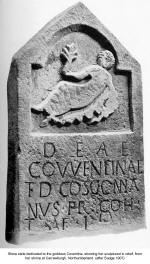
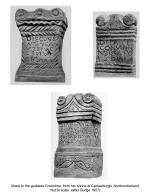 Coventina was another water-goddess .
Her shrine outside the Roman fort of Carrawburgh was excavated in the nineteenth
century. Her name is Celtic but she was not equated with one of the great deities
of the Roman state. On inscriptions she is addressed as a nymph, and is portrayed as such on sculptures. She attracted dedication from soldiers of all ranks. Near to her shrine was
a mithraeum, and also a small open-air shrine to the nymphs and the Genus Loci, and the dedicator there, a prefect, obviously saw the nymphs as separate from
Coventina. It was common for groups of shrines to exist alongside each other,
each with a separate deity having its own title and its own ceremonies. Extreme
localisation, such as this, came about because people were anxious that the
shrine of every divine power received its due. Indeed, anxiety appears to have
invaded the sleep of ordinary people as an altar found beside a spring at Risingham
records ‘Forewarned in a dream, the soldier bade her who is married to Fabius
to set up this altar to the Nymphs who are to be worshiped’.
Coventina was another water-goddess .
Her shrine outside the Roman fort of Carrawburgh was excavated in the nineteenth
century. Her name is Celtic but she was not equated with one of the great deities
of the Roman state. On inscriptions she is addressed as a nymph, and is portrayed as such on sculptures. She attracted dedication from soldiers of all ranks. Near to her shrine was
a mithraeum, and also a small open-air shrine to the nymphs and the Genus Loci, and the dedicator there, a prefect, obviously saw the nymphs as separate from
Coventina. It was common for groups of shrines to exist alongside each other,
each with a separate deity having its own title and its own ceremonies. Extreme
localisation, such as this, came about because people were anxious that the
shrine of every divine power received its due. Indeed, anxiety appears to have
invaded the sleep of ordinary people as an altar found beside a spring at Risingham
records ‘Forewarned in a dream, the soldier bade her who is married to Fabius
to set up this altar to the Nymphs who are to be worshiped’.

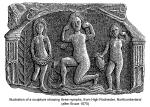
The ‘native’ deities
Seventy Celtic deities are known from Britain, and of these twenty-one
are also known on the Continent (see table, and selected discussion below).
Occasionally where the name of the sprit was not known, the dedication would
be just to the ‘genius’ or spirit of the place.
| Deity name: |
Known only in Britain |
Known in Britain and on
Continent |
Evidence: |
|
Abandinus |
Yes |
|
Godmanchester (Britannia 4,
(1973), 325, no. 4) |
|
Ancasta |
Yes |
|
RIB 97 (Bitterne, Hants.) |
|
Andate |
Yes |
|
from Cassius Dio, 62, 7, 3. Poss.
also equated with Nike=Victoria |
|
Andraste |
Yes |
|
from Cassius Dio, 62, 6, 1-2. |
|
Antenociticus |
Yes |
|
RIB 1327, 28 & 29
(Benwell) |
|
Apollo Anextlomarus |
|
Yes |
RIB 1162 (Arbeia) |
|
Apollo Cunomaglus |
Yes |
|
West Kington, Wilts (JRS 52 (1962),
191, no. 4) |
|
Apollo Grannus |
|
Yes |
RIB 2132 (Inveresk) Two cult centres:
i) Faimingen (Raetia), ii) Aachen (Germania inf.) |
|
Arciacones |
Yes |
|
RIB 640 (York) |
|
Arecurius |
Yes |
|
RIB 1123 (Corbridge) |
|
Arnemetia |
Yes |
|
from Ravenna Cos. possibly Aquae
Arnemetiae at Buxton, Derbyshire |
|
Arnomecta |
Yes |
|
RIB 281 (Brough-on-Noe) |
|
Belatucadrus |
Yes |
|
various spellings. Sometimes equated
with Mars. specific W. end of HW distribution |
|
Bregantes |
Yes |
|
RIB 623 (Slack, Yorks.) |
|
Brigantia |
Yes |
|
6 insc. suggesting that she was
the special patroness of the Brigantes! |
|
Britannia |
Yes |
|
RIB 643 (York) & 2195
(Castlehill) |
|
Cocidius |
Yes |
|
sometimes equated with Mars or Silvanus
also Vernostonus. Ravenna lists a fanum Cocidi, possibly Bewcastle |
|
Contrebis |
Yes |
|
RIB 610 (Burrow in Lonsdale) but
also on RIB 600 where his name is attached as an epithet to Ialonus |
|
Coventina |
|
Yes |
RIB 1522-35 |
|
Cuda |
Yes |
|
RIB 129 (Daglingworth, Glos.) shown
as a mother goddess alongside Genii cucullati |
|
Digenis |
|
Yes |
RIB 1044 (Ch.-le-St.) & 1314
(MC3) |
|
Epona |
|
Yes |
RIB 967 (Netherby), 1777 (Carvoran),
2177 (Auchendavy) & AE1966,239 (Alcester) |
|
Hercules Saegon[tius] |
Yes |
|
RIB 67 (Silchester) |
|
Ialonus |
|
Yes |
RIB 600 (n. of Lancaster) |
|
Ioug[----] |
Yes |
|
RIB 656 (York) |
|
Ixsaosc(os) |
Yes |
|
variant spellings, from 4 bronze
rings found at Caistor = Venta Icenorum |
|
Latis |
Yes |
|
RIB 1897 (Birdoswald) & 2043
(Folksteads nr. Kirkbampton, Cumb.) |
|
Maponus |
Yes |
|
6 insc., 4 of which equate him with
Apollo (the harpist not the hunter). Possibly a female goddess assoc
with him. |
|
Mars Alator |
Yes |
|
RIB 218 (Barkway, Herts) and 1055
(Arbeia) |
|
Mars Barrex/Barregis |
Yes |
|
RIB 947 (Carlisle) |
|
Mars Braciaca |
Yes |
|
RIB 278 (Bakewell, Derbys.) |
|
Mars Camulus |
|
Yes |
RIB 2166 (Bar Hill) Well
known as god of the Remi – ILS235 (Rindern) & AE1935 (Reims) |
|
Mars Condantes |
Yes |
|
RIB 731 (Bowes); 1024 (Piercebridge) & 1045
(Ch.-le-St.) |
|
Mars Corotiacus |
Yes |
|
RIB 213 (Martlesham, Suffolk) |
|
Mars Lenus |
|
Yes |
RIB 126 (Chedworth) & 309
(Caerwent) |
|
Mars Loucetius |
|
Yes |
RIB 140 (Bath) |
|
Mars Medocius |
Yes |
|
RIB 191 (Colchester) |
|
Mars Nodens |
Yes |
|
insc. on bronze and lead from Lydney
the centre of the cult |
|
Mars Ocelus |
Yes |
|
equated with Mars Lenus (see above),
also on RIB 310 (Caerwent) & 949 (Carlisle) |
|
Mars Olludius |
|
Yes |
RIB 131 (Custon Scrubs, Bisley,
Glos.) |
|
Mars Rigas |
Yes |
|
RIB 711 (Malton) |
|
Mars Rigisamus |
|
Yes |
RIB 187 (West Coker, Somerset) |
|
Mars Rigonemetes |
Yes |
|
insc. from Nettleham, Lincs. (JRS
52 (1962), 192, no.8) |
|
Mars Toutates |
|
Yes |
RIB 219 (Barkway, Herts.) & 1017
(?Cumberland) |
|
Mars Vellanus |
|
Yes |
on 309 (see above), where the god
Marc Ocelus is given the epithet Vellaun(us) |
|
Matres |
|
Yes |
approx. 60 dedications. Many have
further definition incl. Alatervae, Campestres, Communes, Domesticae,
Ollototae, Parcae, Suae, Suleviae & Transmarinae, plus 5 Matres of various people. |
|
Matunus |
Yes |
|
RIB 1265 (High Rochester) |
|
Mogons |
|
Yes |
and various other spellings! |
|
Mounus |
|
Yes |
thought to be a misspelling of Mogons,
but also known from Gaul, CIL XIII 10012, 19 (samian ves.), ded. to Mouno. |
|
Nemetona |
|
Yes |
from RIB 140
(Bath) alongside Mars Loucetius (see above) |
|
Ratis |
Yes |
|
RIB 1454 (Chesters) & 1903
(Birdoswald) |
|
Rioclates |
Yes |
|
insc. from somewhere in Cumberland? |
|
Saitada |
Yes |
|
RIB 1695 (Beltingham) |
|
Setlocenia |
Yes |
|
RIB 841 (Maryport) |
|
Silvanus Callirius |
Yes |
|
RIB 194 bronze plate (Colchester) |
|
Silvanus Cocidius |
Yes |
|
Cocidius equated with Silvanus on RIB 1578
(Housesteads) and 1207 (Risingham) |
|
Sucellus |
|
Yes |
silver ring from York insc. deo
Sucelo |
|
Suleviae |
|
Yes |
4-5 insc. one of which is Matres
Suleviae. Ded. by civilians! |
|
Sulis |
|
Yes |
all insc. from Bath, except for
CIL XIII 6266 from Alzei, suggesting that cult brought to Rhineland
from a visitor to Bath. |
|
Tanarus |
Yes |
|
from an altar found at Chester in
1653. Text now unreadable! |
|
Tridamus |
Yes |
|
RIB 304 (Michaelchurch, S. of Hereford
–not a Roman site!) |
|
Tuetela Boudriga |
|
Yes |
single altar found in Bordeaux is
only evidence, BUT as it is ded. by a certain Lunaris, a poss. trader
from York. May have been shipped there as ballast |
|
V[------] |
Yes |
|
fragmentary insc. from Wroxeter
(JRS 52 (1962), 192, no. 9) |
|
Vanauntes |
Yes |
|
RIB 1991 (nr. Castlesteads) |
|
Verbia |
Yes |
|
RIB 635 (Ilkley) |
|
Vernostonus |
Yes |
|
RIB 1102 (Ebchester), equated with
Cocidius |
|
Veteris |
Yes |
|
many variations in spelling. More
of an E. end of HW dist. |
|
Vinotonus |
Yes |
|
RIB 732 & 733 from
two shrines on the moors S. of Bowes and poss. 3 others 735/6/7. |
|
Viridius |
Yes |
|
alter found in 1961 at Ancaster
(JRS 52 (1962) |
|
Mercurius Andescovivoucus |
Yes |
|
RIB 193 (Colchester) found in 1764
(now lost!) |
Comparison study – the villa region of Western England and North-east
England
In Western England a concentration of sculpture and inscriptions can be
seen to correspond to the richer villa zone, while in North-east England, especially
on the northern frontier, the native deities appear to have distinct distributions,
possibly relating to the nature of the military presence. In both of these
areas native deities predominate, overshadowing the official state religion,
however, a definite distinction could be made between the military zones and
the civilian, where in the latter the Roman and native gods appear to be ‘harmoniously
intertwined’, while in the former ‘a sentina numinium, a kitchen-midden of all sorts of cults heaped up from all quarters of the Empire’,
prevailed (Haverfield 1923, 73).
The villa region of Western England
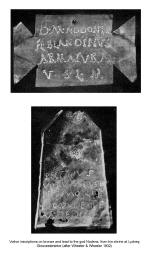
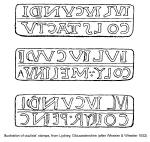 An example of a wholly British deity is Nodens, or Nodons.
His main sanctuary was at Lydney (Gloucestershire) on the river Severn, where
he is mentioned either alone or equated with both Mars and Silvanus. He was
essentially a hunting god, but was also associated with water and healing.
His large temple complex was centred on a therapeutic spring, which also contained
a number of buildings including a dormitory. There are no representations of
him in human form and the finding of representations of dogs from the site may suggest that he either took that form or that he was attended
by a dog (similar to the healer god Aesculapius). Finds of oculists’ stamps
(collyrium or salve stamps) confirm his aspect of healing. His temple complex was not founded before the
third-century AD and has been associated with a re-emergence of cult activity
in the southwest dating to late third and fourth century.
An example of a wholly British deity is Nodens, or Nodons.
His main sanctuary was at Lydney (Gloucestershire) on the river Severn, where
he is mentioned either alone or equated with both Mars and Silvanus. He was
essentially a hunting god, but was also associated with water and healing.
His large temple complex was centred on a therapeutic spring, which also contained
a number of buildings including a dormitory. There are no representations of
him in human form and the finding of representations of dogs from the site may suggest that he either took that form or that he was attended
by a dog (similar to the healer god Aesculapius). Finds of oculists’ stamps
(collyrium or salve stamps) confirm his aspect of healing. His temple complex was not founded before the
third-century AD and has been associated with a re-emergence of cult activity
in the southwest dating to late third and fourth century.
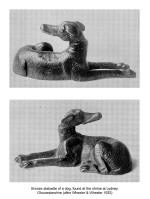
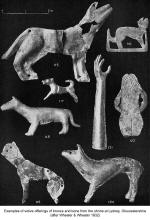
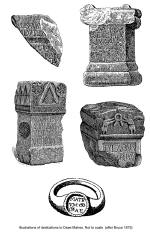
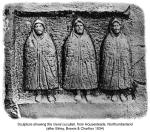 Two native cults that appear in both regions but which are perhaps more
common in Western England are those of the Deae Matres – one of the many forms of Mother-Goddesses, and the Genii cucullati – curious representations of three dwarves wearing the Gaulish hooded cloak. The Deae Matres are connected with fertility and are often depicted in triplicate as a group
of female figures carved in simple stone relief, either nursing infants or
with baskets in their laps containing loaves, fruit, or fish symbolising plenty.
Single representations also occur – an example is known from Caerwent - while
a group of four was discovered in London. Depictions can also be found on bronze
and silver plaques. Their distribution includes Hadrian’s Wall, Lincolnshire
and London, but there is a concentration in Western England, notably centred
on Cirencester and Bath where they are known as the Suleviae – a name thought to be linked to Sulis – and are also possibly connected to water and healing springs. The Genii cucullati share an identical distribution to the Deae Matres, being especially common in Cirencester. Their relief carvings appear very crude
and sometimes schematised and they are associated with prosperity, well-being and fertility. In Gloucestershire
they are sometimes found accompanying the mother-goddesses, or shown carrying
eggs, and like them are also connected with ceremonies associated with therapeutic
springs, as evident at Springhead (Kent) and Bath.
Two native cults that appear in both regions but which are perhaps more
common in Western England are those of the Deae Matres – one of the many forms of Mother-Goddesses, and the Genii cucullati – curious representations of three dwarves wearing the Gaulish hooded cloak. The Deae Matres are connected with fertility and are often depicted in triplicate as a group
of female figures carved in simple stone relief, either nursing infants or
with baskets in their laps containing loaves, fruit, or fish symbolising plenty.
Single representations also occur – an example is known from Caerwent - while
a group of four was discovered in London. Depictions can also be found on bronze
and silver plaques. Their distribution includes Hadrian’s Wall, Lincolnshire
and London, but there is a concentration in Western England, notably centred
on Cirencester and Bath where they are known as the Suleviae – a name thought to be linked to Sulis – and are also possibly connected to water and healing springs. The Genii cucullati share an identical distribution to the Deae Matres, being especially common in Cirencester. Their relief carvings appear very crude
and sometimes schematised and they are associated with prosperity, well-being and fertility. In Gloucestershire
they are sometimes found accompanying the mother-goddesses, or shown carrying
eggs, and like them are also connected with ceremonies associated with therapeutic
springs, as evident at Springhead (Kent) and Bath.
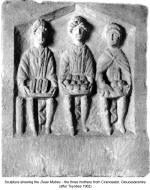
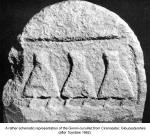
North-east England
In the northern military zone, particularly along Hadrian’s Wall, the
native gods overshadow the official Roman religion and all the other Graeco-Roman
gods (Breeze & Dobson 2000, 281). There are dedications to native deities known throughout
the province, but there are many who are specific to the military zone such
as Antenociticus at Benwell and Coventina, mentioned above, at Carrwburgh,
however, three deities in particular have prolific dedications.
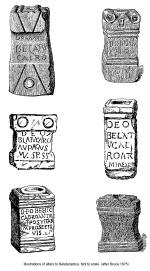 Belatucadrus, of which there are no representations, was mainly worshipped
towards the western end of Hadrian’s Wall, and at Brougham (Cumbria) in the
military hinterland. Often he is equated with Mars and his dedications usually
take the form of small altars set up by the lower ranks of soldier.
Belatucadrus, of which there are no representations, was mainly worshipped
towards the western end of Hadrian’s Wall, and at Brougham (Cumbria) in the
military hinterland. Often he is equated with Mars and his dedications usually
take the form of small altars set up by the lower ranks of soldier.
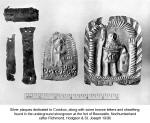 Cocidius also has a similar western distribution, and like Belatucadrus
is often equated with Mars. It is believed that his shrine was situated at
or near Bewcastle (Cumbria) – thought to be the Fanum Cocidi of the Ravenna
Cosmography. Silver plaques from the headquarters building at Bewcastle depict
a more schematised version of him, wearing full armour and holding a spear
of native type. Where Cocidius differs is that he is worshipped by the military,
often by men of superior social standing such as a legionary centurion and
equestrian officers. He is also occasionally represented, in figure form, in rock-cut shrines.
Cocidius also has a similar western distribution, and like Belatucadrus
is often equated with Mars. It is believed that his shrine was situated at
or near Bewcastle (Cumbria) – thought to be the Fanum Cocidi of the Ravenna
Cosmography. Silver plaques from the headquarters building at Bewcastle depict
a more schematised version of him, wearing full armour and holding a spear
of native type. Where Cocidius differs is that he is worshipped by the military,
often by men of superior social standing such as a legionary centurion and
equestrian officers. He is also occasionally represented, in figure form, in rock-cut shrines.
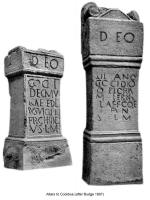
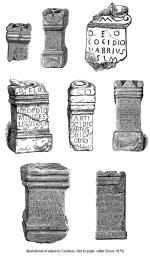
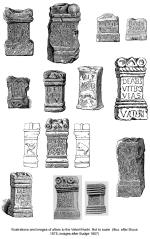 The third unique local deity is a god (or gods) known as the Vetri or
Hveteri, with a multitude of similar spellings, whose distribution is mainly
the central and eastern parts of Hadrian’s Wall, with some sites having large
numbers of dedications (16 at Carvoran, and 9 at Vindolanda). These also tend
to be in the form of small altars, dedicated by the lower classes, although
it has been suggested that the variation in spelling indicates that the deity’s
name could not be expressed easily in
the Latin alphabet (Birley 1979, 107).
The third unique local deity is a god (or gods) known as the Vetri or
Hveteri, with a multitude of similar spellings, whose distribution is mainly
the central and eastern parts of Hadrian’s Wall, with some sites having large
numbers of dedications (16 at Carvoran, and 9 at Vindolanda). These also tend
to be in the form of small altars, dedicated by the lower classes, although
it has been suggested that the variation in spelling indicates that the deity’s
name could not be expressed easily in
the Latin alphabet (Birley 1979, 107).
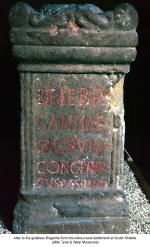
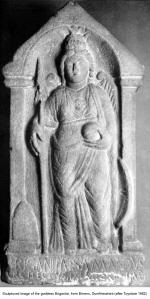 The military zone occupied a large part of the area associated with the
Brigantes and this territory appears to have had its own deity Brigantia: though
the distribution of her dedicationsis incoherent, mainly occurring in two distinct
regions; Hadrian’s Wall and to the north of it (i.e. Birrens); and also the
area of the Calder basin. At
Aldborough, the presumed tribal capital, there is no record of her. Her representation,
from a statue found at Birrens, was described by Richmond as ‘… a remarkable personification, which combines
in one figure the conception of a territorial goddess, with mural crown, a
wargoddess clad like Minerva but with an auxiliary regiment’s style of helmet,
a Victory with wings, and a featureless monolith representing Caelestis’ (1955,
190). On some dedications she is addressed as a water-goddess but not in the
Birrens example.
The military zone occupied a large part of the area associated with the
Brigantes and this territory appears to have had its own deity Brigantia: though
the distribution of her dedicationsis incoherent, mainly occurring in two distinct
regions; Hadrian’s Wall and to the north of it (i.e. Birrens); and also the
area of the Calder basin. At
Aldborough, the presumed tribal capital, there is no record of her. Her representation,
from a statue found at Birrens, was described by Richmond as ‘… a remarkable personification, which combines
in one figure the conception of a territorial goddess, with mural crown, a
wargoddess clad like Minerva but with an auxiliary regiment’s style of helmet,
a Victory with wings, and a featureless monolith representing Caelestis’ (1955,
190). On some dedications she is addressed as a water-goddess but not in the
Birrens example.
Another aspect of the military zone is the occurrence of dedications to
native gods by officers whilst hunting such as the dedications to Vinontonus,
presumed to have been set up in a shrine to the god situated on moorland a
few miles from the fort at Bowes, North Yorkshire.
TWMBibliography
Abbreviations
AE L’anee epigraphique
ANRW Aufsteig und Neidergang der Romischen Welt. Berlin
and New York
CIL Corpus Inscriptionum Latinarum
RIB Collingwood, R. G., & Wright,
R. P. (1965) The Roman Inscriptions of Britain I. Oxford.
Aldhouse-Green, M. J. (2004) ‘Gallo-British Deities and their Shrines’ in Todd.,
M., (ed.) (2004), 193-219.
Allason-Jones, L. & McKay, B. (1985) Coventina’s
Well. Chester.
Birley, A. R. (1964) Life in
Roman Britain. London.
Birley, A. R. (1979) The people of Roman Britain. London.
Birley, E. (1986) ‘The Deities of Roman Britain’, in Hasse,
W. (ed.) Principat. Volume 18. Religion. ANRW, ii, 18, 3-112.
Birley, E., Brewis, P. & Charlton, J.,
(1934) ‘Report for 1933 of the North of England Excavation Committee’, Archaeologia Aeliana 4th series, xi, 176-205.
Breeze, D. J & Dobson, B. (2000) Hadrian’s
Wall. London.
Bruce, J. C., (1875) Lapidarium Septentrionale. Newcastle
upon Tyne.
Budge, J. A. W., (1907) An Account of the
Roman Antiquities preserved in the Museum at Chesters Northumberland. 2nd revised edition. London.
Collingwood, R. G. & Richmond, I. A. (1969) The
Archaeology of Roman Britain. 2nd rev. edn. London.
Green, M. J. (1983) The Gods of Roman Britain. Aylesbury.
Green, M. J. (1998) ‘God in Man’s Image: Thoughts on the Genesis and Affiliations
of some Romano-British Cult-imagery’ Britannia xxix, 17-30.
Haverfield, F. (1923) The Romanization of
Roman Britain. edited by G. Macdonald. Oxford.
Henig, M. (1984) Religion in Roman Britain. London.
Horsley, J., (1732) Britannia Romana.
Ross, A. (1967) Pagan Celtic Britain. Studies in
Iconography and Tradition. London.
Richmond, I, A., Hodgson, K. S. & St.
Joseph, K., (1938) ‘Report of the Cumberland Excavation Committee, directed
by F. G. Simpson. The Roman Fort at Bewcastle’, Transactions of the Cumberland and Westmorland Antiquarian and Archaeological Society, new ser. xxxviii, 195-237.
Todd, M., (ed.) (2004) A Companion to Roman
Britain. Oxford.
Toynbee, J. M. C. (1962) Art in Roman Britain. London.
Wheeler, R. E. M. & Wheeler, T. V., (1932) Report
on the Excavation of the Prehistoric, Roman, and Post-Roman Site in Lydney
park, Gloucestershire. Rep. of the Res. Comm. of the Soc. of Antiq. of London, IX. Oxford.
 Celtic religion was expressed as a belief in ‘the spirits of nature. Sea
and sky, mountains, rivers and trees…the sun, the source of heat and light,
and the moon, the measure of time…’ (Birley 1964, 136). All were thought to
be endowed with powerful spirits, as were certain animals and birds, seen as
having impressive attributes, and all deserving of worship by prayer and sacrifice.
Henig (1984) further emphasises this connection between natural features and
the divine world and claims that place-name evidence suggests that rivers in
particular received names long before the Celtic language was spoken, i.e.
the Thames may have been so named in the Bronze Age or earlier (ibid. 17). Further examples of the worship of these personified natural features include
Verbia, meaning ‘winding river’, attested on an altar at Ilkley, North Yorkshire
(RIB 635). This connection with water - the veneration of rivers and watery places,
especially bogs - is also attested in the numerous offerings of precious objects.
The
earth itself was also thought to be sacred. Shafts were sunk into the ground
in the Bronze Age and became more frequent in the Iron Age and Roman periods.
Evidence of sacrifices in these pits, along with the presence of great timbers,
suggests a symbolic sexual penetration of the earth thus constituting fertility
magic.
Celtic religion was expressed as a belief in ‘the spirits of nature. Sea
and sky, mountains, rivers and trees…the sun, the source of heat and light,
and the moon, the measure of time…’ (Birley 1964, 136). All were thought to
be endowed with powerful spirits, as were certain animals and birds, seen as
having impressive attributes, and all deserving of worship by prayer and sacrifice.
Henig (1984) further emphasises this connection between natural features and
the divine world and claims that place-name evidence suggests that rivers in
particular received names long before the Celtic language was spoken, i.e.
the Thames may have been so named in the Bronze Age or earlier (ibid. 17). Further examples of the worship of these personified natural features include
Verbia, meaning ‘winding river’, attested on an altar at Ilkley, North Yorkshire
(RIB 635). This connection with water - the veneration of rivers and watery places,
especially bogs - is also attested in the numerous offerings of precious objects.
The
earth itself was also thought to be sacred. Shafts were sunk into the ground
in the Bronze Age and became more frequent in the Iron Age and Roman periods.
Evidence of sacrifices in these pits, along with the presence of great timbers,
suggests a symbolic sexual penetration of the earth thus constituting fertility
magic.













 Belatucadrus
Belatucadrus Cocidius
Cocidius



